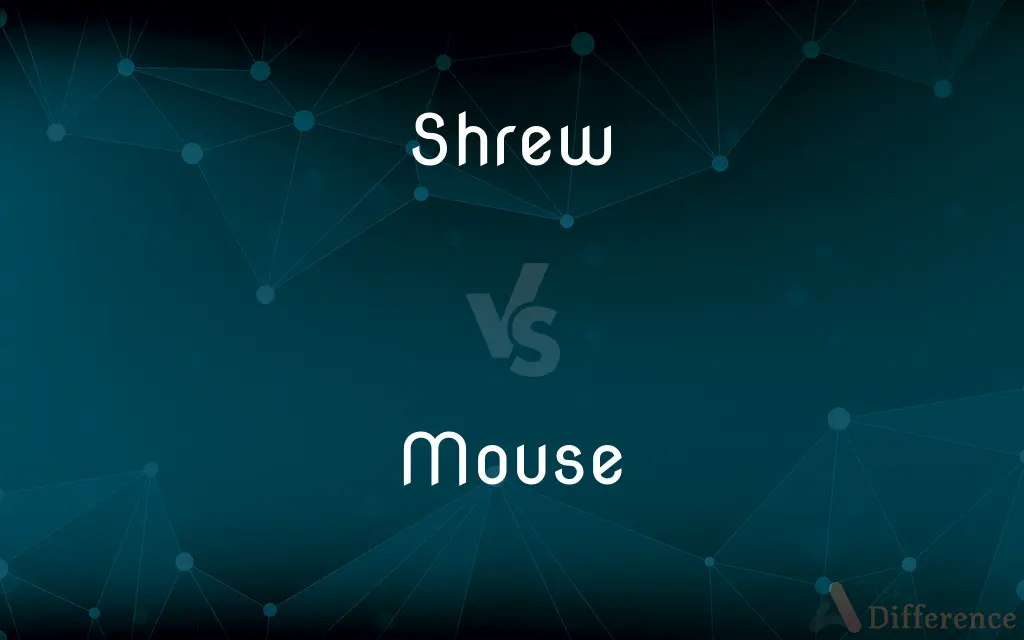Shrew vs. Mouse — What's the Difference?
By Maham Liaqat & Fiza Rafique — Updated on April 5, 2024
Shrews are small, insectivorous mammals with pointed snouts and sharp teeth, lacking visible ears and tail fur, while mice are rodents with rounded snouts, grinding teeth, visible ears, and furry tails.

Difference Between Shrew and Mouse
Table of Contents
ADVERTISEMENT
Key Differences
Shrews, belonging to the order Eulipotyphla, are known for their voracious appetite for insects and small invertebrates, possessing pointed snouts and sharp, spike-like teeth for piercing and holding prey. On the other hand, mice, members of the order Rodentia, primarily consume seeds, fruits, and grains, utilizing their rounded snouts and specialized grinding teeth to process a variety of plant materials. This dietary difference reflects their distinct ecological roles and feeding mechanisms.
The body size of shrews is generally small, with some species weighing less than a coin, making them among the smallest of mammals. Mice, while also small, are usually larger than most shrew species and can vary significantly in size depending on the species. This size distinction is crucial for their respective survival strategies, habitat selection, and predation risks.
Shrews have a higher metabolic rate, requiring them to eat nearly constantly to survive, which influences their behavior and life span, typically shorter than that of mice. Mice have a lower metabolic rate, which allows for less frequent feeding and contributes to a longer lifespan, in addition to enabling a wider range of habitats from wild fields to human dwellings.
In terms of reproduction, shrews have a rapid reproductive cycle but a shorter lifespan, leading to a strategy of producing many offspring quickly. Mice also reproduce rapidly and can have several litters per year, but their slightly longer lifespan allows for more reproductive events over their life.
Shrews have a unique feature: their venomous saliva, which helps them immobilize prey, a trait not found in mice. Mice, in contrast, rely on their agility and social behaviors for survival and foraging, showcasing the diverse evolutionary adaptations between these two small mammal groups.
ADVERTISEMENT
Comparison Chart
Order
Eulipotyphla
Rodentia
Diet
Insectivorous (insects, worms)
Omnivorous (seeds, fruits, grains)
Teeth
Sharp, spike-like for piercing
Rounded, for grinding
Body Size
Generally smaller
Usually larger than shrews
Metabolic Rate
Higher, requires constant feeding
Lower, less frequent feeding
Lifespan
Shorter, often less than 2 years
Longer, can live several years
Reproduction
Rapid cycle, many offspring quickly
Several litters per year, longer lifespan allows more reproductive events
Unique Features
Venomous saliva, no visible ears
Visible ears, furry tail
Compare with Definitions
Shrew
Small, insect-eating mammals with pointed snouts.
The common shrew uses its sharp teeth to hunt insects and spiders.
Mouse
Small rodents with rounded snouts and grinding teeth.
The house mouse uses its teeth to gnaw through grains.
Shrew
Known for their high metabolic rate.
A shrew must eat constantly to sustain its energy needs.
Mouse
Omnivorous, eating seeds, fruits, and grains.
Mice can often be found foraging in fields and storerooms.
Shrew
Lacks visible ears and tail fur.
Despite its lack of visible ears, the shrew has excellent hearing.
Mouse
Visible ears and a furry tail.
The deer mouse is easily identified by its large ears and bushy tail.
Shrew
Can have venomous saliva to immobilize prey.
The Eurasian water shrew secretes venom to paralyze its prey.
Mouse
Adaptable to a wide range of environments.
Mice have colonized almost every landmass on Earth.
Shrew
Short lifespan with rapid reproduction.
Shrews can reproduce multiple times in their brief lives.
Mouse
Reproduces rapidly, with several litters per year.
House mice can produce a new litter every month.
Shrew
Shrews (family Soricidae) are small mole-like mammals classified in the order Eulipotyphla. True shrews are not to be confused with treeshrews, otter shrews, elephant shrews, West Indies shrews, or marsupial shrews, which belong to different families or orders.
Mouse
A mouse, plural mice, is a small rodent. Characteristically, mice are known to have a pointed snout, small rounded ears, a body-length scaly tail, and a high breeding rate.
Shrew
A small insectivorous mammal resembling a mouse, with a long pointed snout and tiny eyes.
Mouse
A small rodent that typically has a pointed snout, relatively large ears and eyes, and a long tail.
Shrew
A bad-tempered or aggressively assertive woman
Hold your nagging tongue, you miserable old shrew!
Mouse
A small handheld device which is moved across a mat or flat surface to move the cursor on a computer screen
The right mouse button
Copy the file with a click of the mouse
Shrew
Any of various small, chiefly insectivorous mammals of the family Soricidae, resembling a mouse but having a long pointed snout and small eyes and ears. Also called shrewmouse.
Mouse
A lump or bruise on or near the eye
She touched the mouse under her eye
Shrew
A woman regarded as an ill-tempered scold or nag.
Mouse
(of a cat or owl) hunt for or catch mice
Female cats are usually much better at mousing than males
Shrew
Any of numerous small, mouselike, chiefly nocturnal, mammals of the family Soricidae (order Soricomorpha).
Mouse
Use a mouse to move or position a cursor on a computer screen
Simply mouse over any item on the list
Shrew
Certain other small mammals that resemble true shrews (order Soricomorpha).
Mouse
Any of numerous small rodents of the families Muridae and Cricetidae, such as the house mouse, characteristically having a pointed snout, small rounded ears, and a long naked or almost hairless tail.
Shrew
(pejorative) An ill-tempered, nagging woman: a scold.
Mouse
Any of various similar or related animals, such as the jumping mouse, the vole, or the jerboa.
Shrew
To beshrew; to curse.
Mouse
A cowardly or timid person.
Shrew
Wicked; malicious.
Mouse
(Informal) A discolored swelling under the eye caused by a blow; a black eye.
Shrew
Any small insectivore of the genus Sorex and several allied genera of the family Sorecidæ. In form and color they resemble mice, but they have a longer and more pointed nose. Some of them are the smallest of all mammals.
Mouse
Pl. mice or mous·es (mousĭz) Computers A handheld, button-activated input device that when rolled along a flat surface directs an indicator to move correspondingly about a computer screen, allowing the operator to move the indicator freely, as to select operations or manipulate text or graphics.
Shrew
To beshrew; to curse.
Mouse
To hunt mice.
Shrew
A scolding nagging bad-tempered woman
Mouse
To search furtively for something; prowl.
Shrew
Small mouselike mammal with a long snout; related to moles
Mouse
Any small rodent of the genus Mus.
Mouse
(informal) A member of the many small rodent and marsupial species resembling such a rodent.
Mouse
A quiet or shy person.
Mouse
(computing) (plural mice or, rarely, mouses) An input device that is moved over a pad or other flat surface to produce a corresponding movement of a pointer on a graphical display.
Mouse
(computing) The cursor.
Mouse
(boxing) A facial hematoma or black eye.
Mouse
(nautical) A turn or lashing of spun yarn or small stuff, or a metallic clasp or fastening, uniting the point and shank of a hook to prevent its unhooking or straightening out.
Mouse
(obsolete) A familiar term of endearment.
Mouse
(set theory) A small model of (a fragment of) Zermelo-Fraenkel set theory with desirable properties (depending on the context).
Mouse
(historical) A small cushion for a woman's hair.
Mouse
Part of a hind leg of beef, next to the round.
Mouse
(intransitive) To move cautiously or furtively, in the manner of a mouse (the rodent) (frequently used in the phrasal verb to mouse around).
Mouse
(intransitive) To hunt or catch mice (the rodents), usually of cats. 12
Mouse
To close the mouth of a hook by a careful binding of marline or wire.
Mouse
To navigate by means of a computer mouse.
Mouse
To tear, as a cat devours a mouse.
Mouse
Any one of numerous species of small rodents belonging to the genus Mus and various related genera of the family Muridæ. The common house mouse (Mus musculus) is found in nearly all countries. The American white-footed mouse, or deer mouse (Peromyscus leucopus, formerly Hesperomys leucopus) sometimes lives in houses. See Dormouse, Meadow mouse, under Meadow, and Harvest mouse, under Harvest.
Mouse
A knob made on a rope with spun yarn or parceling to prevent a running eye from slipping.
Mouse
A familiar term of endearment.
Mouse
A dark-colored swelling caused by a blow.
Mouse
To watch for and catch mice.
Mouse
To watch for or pursue anything in a sly manner; to pry about, on the lookout for something.
Mouse
To tear, as a cat devours a mouse.
Mouse
Any of numerous small rodents typically resembling diminutive rats having pointed snouts and small ears on elongated bodies with slender usually hairless tails
Mouse
A hand-operated electronic device that controls the coordinates of a cursor on your computer screen as you move it around on a pad; on the bottom of the mouse is a ball that rolls on the surface of the pad;
A mouse takes much more room than a trackball
Mouse
To go stealthily or furtively;
..stead of sneaking around spying on the neighbor's house
Mouse
Manipulate the mouse of a computer
Common Curiosities
Can shrews be considered rodents?
No, shrews are not rodents; they belong to the order Eulipotyphla, making them distinctly different from rodents like mice.
Do shrews have a higher metabolic rate than mice?
Yes, shrews have a higher metabolic rate, requiring almost constant feeding to maintain their energy levels.
Are all shrews venomous?
Not all, but some shrew species have venomous saliva to help immobilize their prey.
What is the main difference between shrews and mice?
The main difference lies in their taxonomic order, dietary habits, and physical characteristics like teeth structure and body features.
Can mice eat insects like shrews?
While mice are omnivorous and can eat insects, their diet primarily consists of seeds, grains, and fruits.
Do shrews have visible ears like mice?
Shrews typically do not have visible ears, a feature that distinguishes them from mice.
What habitats are preferred by shrews and mice?
Shrews prefer dense vegetation and moist environments for hunting, while mice are more versatile, inhabiting fields, forests, and human areas.
Why are mice more commonly found in human environments?
Mice are more adaptable to a variety of environments, including human dwellings, due to their omnivorous diet and social behaviors.
How do shrews and mice differ in their reproductive strategies?
Both have rapid reproductive cycles, but shrews tend to produce many offspring quickly due to their shorter lifespan, while mice have more reproductive events over a longer life.
How do shrews and mice defend themselves from predators?
Shrews use their speed, agility, and sometimes venom, while mice rely on their agility, burrowing, and social behaviors to evade predators.
Why are mice more commonly used in research than shrews?
Mice are more genetically homogeneous, easier to breed and maintain, making them more suitable for laboratory research than shrews.
What makes shrews hard to keep as pets compared to mice?
Shrews' high metabolic rate and specialized diet make them difficult to care for in captivity compared to the more adaptable and omnivorous mice.
How can you distinguish a shrew from a mouse in the wild?
By observing their size, snout shape, ear visibility, and tail fur, you can differentiate a shrew from a mouse.
Are mice considered a pest in many regions?
Yes, due to their adaptability and diet, mice are often considered pests in agricultural and urban environments.
What role do shrews play in the ecosystem?
Shrews are important predators of insects and invertebrates, helping control pest populations and recycle nutrients.
Share Your Discovery

Previous Comparison
Birthmark vs. Mole
Next Comparison
Blacklist vs. BlocklistAuthor Spotlight
Written by
Maham LiaqatCo-written by
Fiza RafiqueFiza Rafique is a skilled content writer at AskDifference.com, where she meticulously refines and enhances written pieces. Drawing from her vast editorial expertise, Fiza ensures clarity, accuracy, and precision in every article. Passionate about language, she continually seeks to elevate the quality of content for readers worldwide.














































